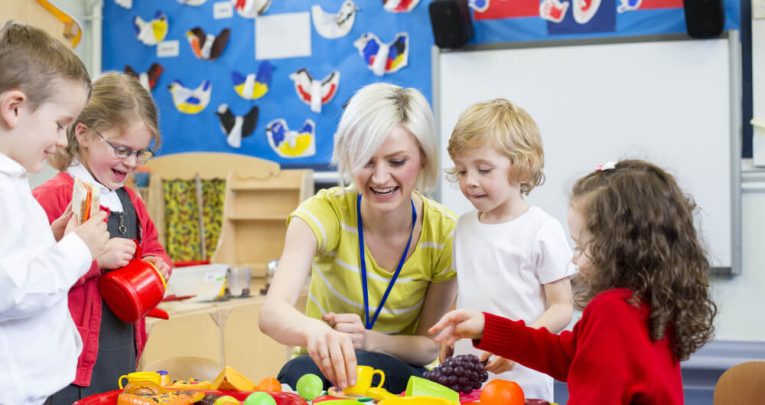How to Make the Most of Role Play in Early Years

With a little planning and forethought you can create a space that will inspire your children’s imaginative play for weeks to come, says Nikky Smedley…

Different schools utilise role play in different ways, but I don’t think I’ve ever worked in a nursery or Reception setting that didn’t include it in some way.
The least successful methodologies I have witnessed have been when a certain area of the room is set aside as the role-play space, the theme is decided by the teacher every half-term (usually on the same rotation each year) and some cloth and a few relevant props and bits of costume have been put in the corner to remain, undeveloped or added to, for the duration.
It’s a bit tick-box. I’m not saying that you have to create an amazing theatrical extravaganza, but I am saying that it needs to be thought about, whatever way you decide to tackle it.
What do you want to achieve?
The first question to ask yourself is what do you want the children to get from their role play? If you decide that you want them to develop focus then you might want to limit the range of what they have at their disposal – rabbit ears and tubes, for instance.
If, on the other hand, you want them to work on decision making and cooperation, then it makes sense to give them a subject with the potential for lots of alternative stimuli, such as ‘jobs people do’.
Or if it’s their creativity and self-expression you want to encourage, then you could give them something quite minimalist and open, maybe black paper on the walls, silver pens, silver foil, silver card and safe scissors, so that they can create their own night-time sky environment.
One school I know opted for a huge gauze cube (each side around five foot long) with pockets and places to hang things – you could see through it, but once inside it felt very cosy and secure, and it allowed the children to adapt the space to whatever imaginative journey they felt like going on that day.
Then there’s the structure of your role play to consider. Do you have an identified area, and if so, how long will you keep one theme in place?
Alternatively, or if your room doesn’t have space for that, perhaps a designated time for role play is a viable option. Some people like to hold a big event, such as Arctic Week, and still others embed role play into their regular choices for the children.
There isn’t a right or a wrong way, it just needs to be thought about. In the past I have heard, “We just don’t have time!” But with a bit of planning and forethought you can set up something that will last for several weeks, that requires little maintenance and which continues to inspire your children.
Let children share their views
In my experience, role play works best if the children are involved right from the beginning – especially if you are going to have a specific role-play area.
Decide with the group what the role-play theme should be. In offering up your suggestions, cover choices based on different people, places, narratives – even try more abstract concepts such as bright, soft or hot.
Yes, there will probably be some divide, and sadly it is still often along stereotypical gender lines, but it’s a good learning process for the children, and you can always remind them that it can be changed further down the line.
Once your theme is decided, make a proper plan together, talk about how it should look, maybe even design and draw it out on paper. You could have examples at the ready to help them along, but do watch out for their desire to just copy whatever you suggest!
If the children are able to contribute to the space, they are more likely to treat it with the level of respect that you’re aiming for. I remember a beautiful tree made by the children in one Reception class.
Everyone painted bits of paper brown for the bark and stuck them onto the basic wire structure. The whole class made leaves to stick to the top and gradually, woodland creatures and birds were added, whether hand-made or toys brought in.
For a whole term the children were various woodland creatures and elves and fairies that lived in the trunk around the roots, as well as birds that nested in the branches – it was gorgeous.
Not terribly robust, in truth, but it lasted because they thought of it as theirs and they wanted it to stay functioning and available for them to play in.
Join in the fun
Most schools have story days, or celebrate World Book Day by dressing up. It’s always the staff who don’t really join in who end up looking a bit wrong.
The children love it so much and it’s an opportunity for you to display your sense of fun – to show your commitment to them in a playful way.
I do hope you have occasions where you too can indulge in a bit of role play and really enter into the spirit of things.
Your children will love you for it, and will therefore want to please and to learn from you more.
One wonderful Reception class I worked with created a fantastic project around The Gingerbread Man.
The children got one of the teachers to lie down on some tough card and they drew around her. Then with the application of rusty coloured cloth, paper, paint and tissue, they transformed this outline into a gigantic gingerbread man.
They then used this massive puppet to play out the story, with all the children joining in. The re-enactment got a bit boisterous, but there was plenty of problem solving and cooperation in there.
This is all a tremendous amount of fun, but we also have to knuckle down and ask ourselves how we capture what the children get up to in role play, especially if it’s undirected.
How do we assess what’s going on for them and what they are learning?
We also need to ask ourselves how, if at all, this kind of play differs from what they get up to in the playground? What does it mean to them?
Don’t be afraid to instigate some deeper conversations with your children around these issues
Remember…
- Know your purpose – what do you want your role play to achieve?
- Let your children be involved in the decision-making process right from the beginning
- Consider a visit to kick-start the project, and invite parents to participate, either in making or for a special event
Nikky Smedley is a writer, educator and passionate advocate for the child. This article is an edited extract taken from Nikky’s new book, Create, Perform, Teach (Jessica Kingsley Publishers, £14.99), a practical guide for early years practitioners seeking to develop their creativity and performance skills to engage children more effectively.










